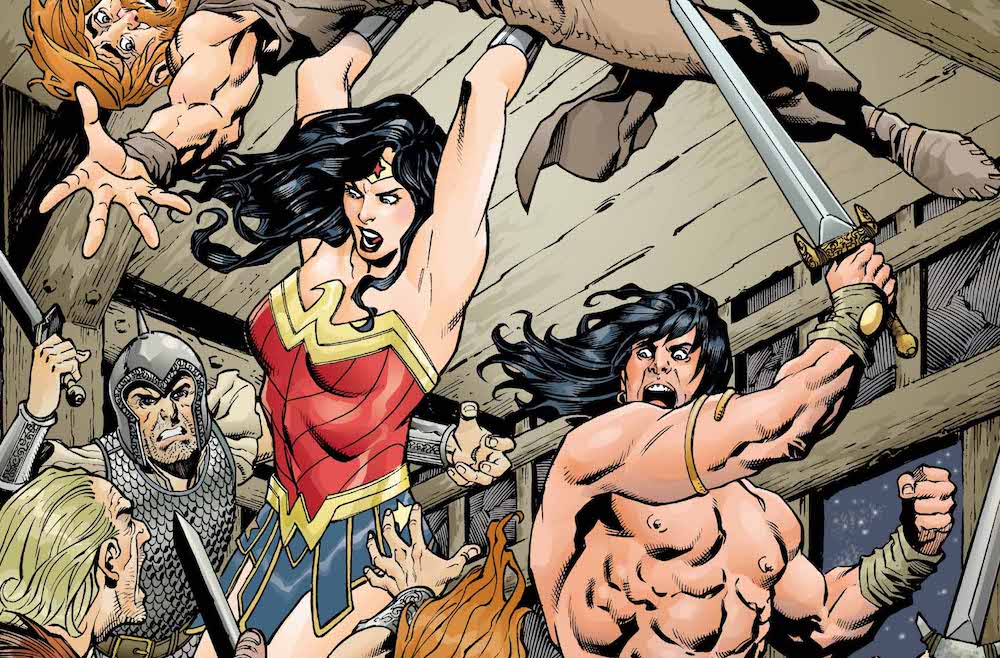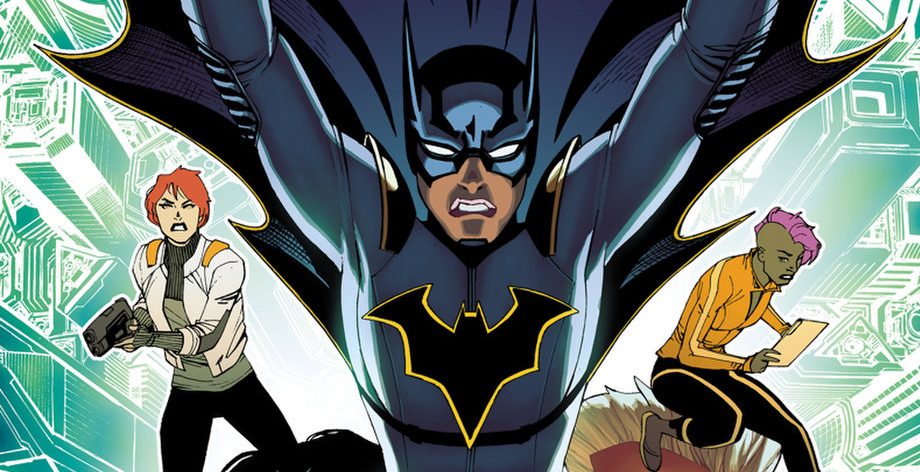
DC scores this week with an all-Batwomen issue in Batman Beyond #12, and with near-perfect issues of Kamandi Challenge, Batman/The Shadow #6, which concludes that crossover, and Batman: Detective Comics #965, with the return of the spotlight to Tim Drake.
Meanwhile Dick and Babs team-up in Batgirl #15; there’s a killer AI on the loose in Batman: Murder Machine #1; the Green Lanterns make a stand at the Source Wall in Hal Jordan and the Green Lantern Corps #29; Ray Palmer tells his story in Justice League of America #15; Jor-El makes his case for Earthlings being useless in Action Comics #988; and Constantine takes a poignant trip down memory lane in The Hellblazer #14.
This, plus reviews of all of this week’s DC Comics.
Warning: Major Spoilers Below!
Spotlight Title:
Batman Beyond #12 – Steve Orlando, Vita Ayala, Writers; Siya Oum, Penciller; Dexter Vines, Inker; Tony Avina, Colorist
Ray – 8/10
Corrina: Return of the Batwomen!
Ray: In the aftermath of the Ra’s Al Ghul arc of Batman Beyond, this title is taking a one-issue break to bring in a guest creative team and bring back a character who was last seen several Batman Beyond incarnations ago. That would be Nissa, the young Batgirl Beyond – a self-made hero without the kind of techno-Batsuit that Terry uses, who trained under Barbara Gordon in a one-shot story during the digital-first Batman Beyond days. This issue expands on Nissa’s story, and shows that she’s from one of the worst areas of Gotham, an area where Batman rarely goes and gangs tend to run wild. Barbara Gordon is investigating some dirty cops in the area when she’s ambushed and captured, and Max receives an alert about this while minding the Batcave in Bruce and Terry’s absence.
Max rarely enters the field, but she puts together an impromptu – and kind of hilarious – costume and seeks out help. Nissa is more than a little skeptical, viewing the Batfamily as more of a distraction than anything, but when she finds out that Barbara is in danger, she agrees to a team-up. The crimefighting is a bit clumsy this issue, with everyone involved getting their chance to screw up, but that also works – the three heroes are a senior citizen who’s been out of the field for decades, a computer jockey, and a teenage girl still in the middle of her training, and it feels like it. There’s a fun, genuine vibe to this issue that shows Vita Ayala – along with her veteran cowriter – has a strong future in DC Comics. I’m hoping this story doesn’t turn out to be a one-off.

Corrina: This series has struggled because it was conceived as a tie-in to the truly awful Futures End event. Since Rebirth, the creative team has attempted to reset it back to the familiar Batman Beyond-verse, quickly disposing of older Tim Drake and re-introducing supposedly dead Terry McGuinness, older Bruce Wayne, and many of his supporting cast, including the Justice League Beyond. That’s made it less about story and more about set-piece to put the broken toys back together, though there have been some good moments.
But nothing like this issue, which is wonderful. It’s the sequel to Batman: Mystery of the Batwoman that I never expected to have but loved from the first panel to the last. I know, I know, it’s just a fill-in and a one-issue story, as was Nissa’s original introduction in a one-shot story but, clearly, there’s so much more than can be done with these three. More. More. More.
Near Perfect Issues: Grades 9-10
Kamandi Challenge #9 – Tom King, Writer; Kevin Eastman, Freddie Williams II, Artists
Ray – 9.5/10
Corrina: Kamandi, Tom King-style
Ray: Arguably DC’s top writer at the moment, King steps in for his tour of duty on Kamandi and brings with him iconic TMNT writer/artist Kevin Eastman and Freddie Williams II for an extremely dark, moody issue picking up from last issue’s cliffhanger, where Kamandi was swallowed by a sea serpent. But whatever that sea serpent is, it’s not a natural being. Kamandi finds himself not in a creature’s stomach, but in a mysterious prison populated by countless animal people who were also captured. And beyond their small room lies a gate, and once a day, the gate opens. Out comes an unstoppable robot that drags one of their number off to an unknown fate.
The entire issue is done in creepy black and white, in the vein of the classic TMNT (which works nicely due to the various animal hybrids present), and follows Kamandi’s battle against the robot, as he trains, tries new tricks, all as one by one, the population of the room dwindles. There are tiny quibbles with this issue, sure – King really likes his slow-paced, super-intense battle issues, and the recap of the previous issues in the middle feels a tiny bit out of place – but overall, the issue just keeps on building over the twenty-four pages, in easily my favorite chapter of the series since the first. Thus far, Kamandi’s mostly been running from weird animal adventure to another, and the digressions didn’t really work. This is the first one that feels like Kamandi, but with the creator’s distinct stamp on it. It was just weird enough to be the perfect Kirby tribute.
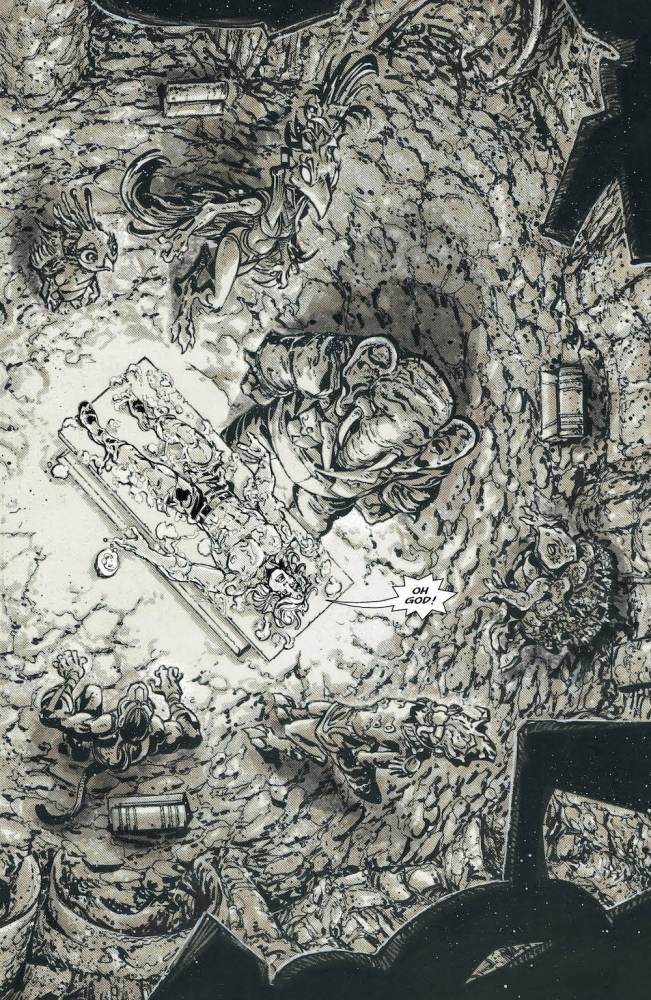
Corrina: This is an intense chapter, with pencils and inks that mesh perfectly with the mood King creates. It’s is the perfect Kirby tribute, especially the quote used at the end.
And, yet, I believe this is the first story where I realized how specific King can be in his style. We’ve seen this type of mood/story in his various works over the last few years, such as Vision, Omega Men, Batman, The Sheriff of Babylon and Mister Miracle. That makes his style distinctive, which is great, but in this particular story, I felt that rather than focusing on the character, it focused on the theme of what King was trying to say. Meaning, the main character could have been Bruce Wayne or Scott Free or Vision. There’s nothing about his reactions that are terribly unique to Kamandi himself. It’s similar to my frustration with Brian Bendis’s dialogue, which sounds the same even with different characters.
There’s no question King is a brilliant writer. I guess I was hoping for something more along the lines of Batman riding an airplane to the ground than this introspective tale.
Batman: Detective Comics #965 – James Tynion IV, Writer; Eddy Barrows, Penciller; Eber Ferreira, Inker; Adriano Lucas, Colorist
Ray – 9.5/10
Corrina: Let’s Get This Rolling!
Ray: No character since the era of the New 52 has been hit harder than Tim Drake, much to the annoyance of his fans. First, all his character development from his ten-year-plus solo series was short-circuited and he was rebooted into a completely different character under Scott Lobdell, and then he was finally restored to something resembling his old self under James Tynion – only to be promptly “killed off” and taken to Mr. Oz’s secret prison for the last year. But now, it’s finally the character’s place in the spotlight under his self-proclaimed biggest fan, and it’s like the character never left. The issue opens with some flashbacks to the classic “A Lonely Place of Dying” storyline that introduced him, and it’s a very welcome development that the character’s first origin is back in continuity. No more witness protection program! Meanwhile, Tim is still in Oz’s cell, being interrogated about his reasons for being a superhero. Although Oz is clearly a chess master, Tim still has some tricks up his sleeve and manages to temporarily escape his cell.
This leads Oz to finally reveal himself as Jor-El to Tim (much more on that later). Jor-El seems clearly impressed by Tim, and even makes clear that he took him primarily because Tim’s one of the individuals who has gotten the attention of the evil forces watching the world – likely the Watchmen. Oz’s real motivations are still a mystery, but he’s clearly impressed with Tim, even letting Tim out of his cell and giving him run of the prison. Tim – likely as Oz knew he would – immediately makes an attempt to contact people outside of the prison, and gets the attention of Batman. A Batman, at least – it turns out to be a gun-toting Batman, who is none other than the Titans of Tomorrow Tim Drake. This is a Tim Drake who essentially gave up his humanity to save Conner Kent and Bart Allen, so even though they’re not here in body, they’re clearly present here. They’re fighting Doomsday next issue, but there’s a huge story being set up here, in what looks like the best Tim Drake story in years.
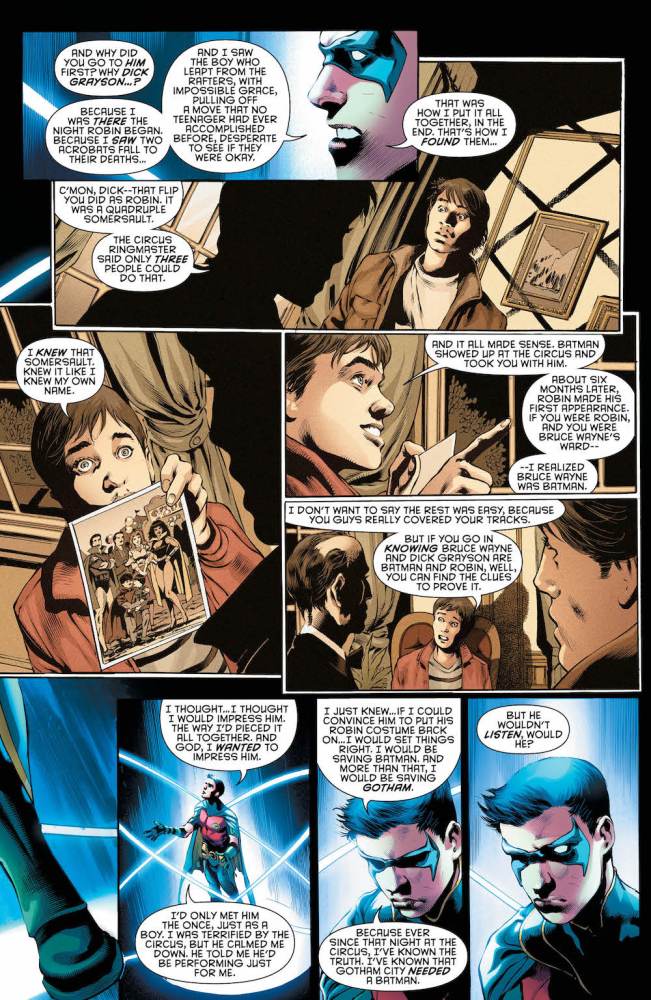
Corrina: I can’t give this a high a grade as Ray. He’s thrilled Tim Drake is back, as originally conceived, and that’s all to the good but this issue is mainly a recap issue of his history, rather than a story. It’s a well-done recap, yes, but it’s mostly setup and little action.
If you’ve read Batman: A Lonely Place of Dying, or the early issues of Tim Drake’s Robin series, this will all be familiar territory. If that’s what you’ve been craving and you love Tim, you’ll want this issue. But I’d just hoped for more in motion with this plotline, especially since Tim has been a captive and we’ve been teased about his escape/rescue for a year. wNo doubt the next issue, now that the stage has been set, will finally get to the meat of this tale.
Batman/The Shadow #6 – Scott Snyder, Steve Orlando, Writers; Riley Rossmo, Artist; Ivan Plascencia, Colorist
Ray – 9/10
Corrina: Incredible Crossover
Ray: A strange, cosmic wrap-up to one of the best crossovers DC has ever written, setting the stage for more adventures in the coming Dynamite sequel. The issue’s opening threw me for a loop, as it picks up with Bruce Wayne dead, in the cosmic beyond being met with a group of Lovecraftian horrors, the spirits powering Shamba-La. Their entire source of power is in danger, and they’ve brought Bruce in to try to convince him to become another one of their warriors, an immortal agent of the unreal. To convince him, they finally explain the true nature of the Stag – like the Shadow, he gains his immortality from Shamba-La, but not by their choice. The brother of a man who failed to get the power and died in the process, he’s become an immortal agent of vengeance, seeking to destroy everything the Shadow seeks to protect.
Bruce, of course, rejects their offer, because the key element of Batman is his humanity. He instead chooses to return to the battle, restored but still mortal, as Shadow manages to shut Joker up temporarily. Batman figures out a way to destroy the Stag’s plan, but it involves cutting off the connection between Shamba-La and Earth – which will mean Shadow is cut off from them as well, unable to have his curse lifted when the time comes. Lamont Cranston makes the hard choice after a fantastic scene between the two heroes, but they don’t really have it out about the consequences until the end of the issue, where their differing views on the nature of heroism are contrasted. It’s rare to see a comic book crossover that takes both sides this seriously and expands their mythology. It’s so good that a sequel was immediately greenlit, and I’m thrilled because there’s so much more to explore here.
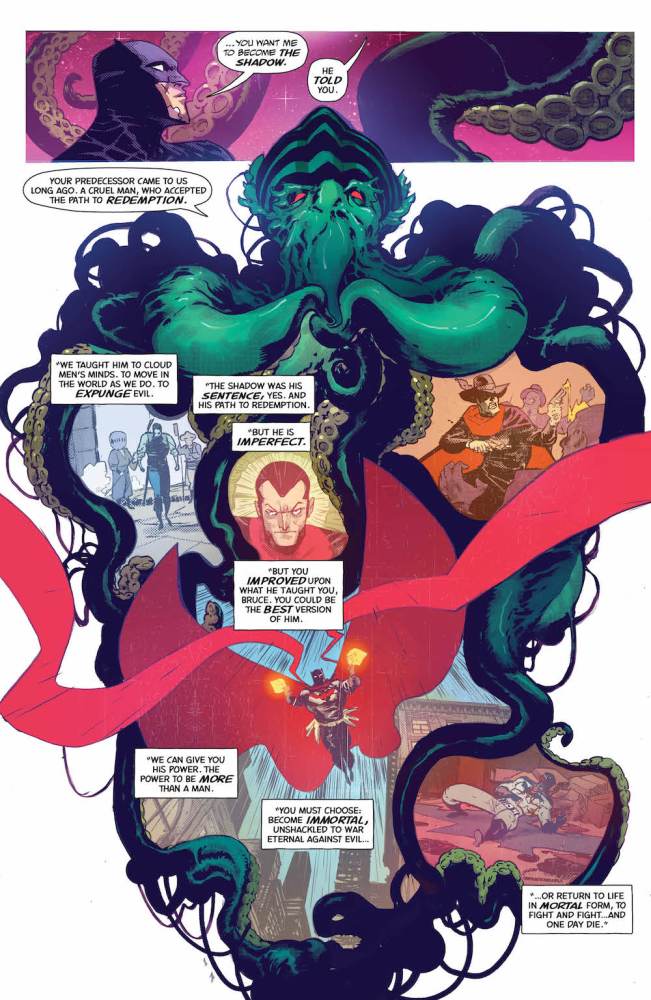
Corrina: A terrific series, steeped in noir, that has been a joy from start to finish. And yet…I’m not sure I completely understood the ending. It’s all very mystical, which was always an aspect of the Shadow, but I’m not sure exactly how Batman survived.
What’s clear, however, is the difference between the two forces of vengeance. One is steeped in compassion, the other has to struggle not to give into darker impulses. (And, no, Batman is not the latter!) I’d love to see a sequel to this, starring Lamont Cranston in the modern day, attempting to juggle his humanity with his curse (or gift, depending on your point of view.)
Fine Issues: Grades 8-9
Superman: Action Comics #988 – Dan Jurgens, Writer; Ryan Sook, Artist; Hi-Fi, Colorist
Ray – 8/10
Corrina: Not Thrilled With Mr. Oz
Ray: Following last issue’s reveal that Mr. Oz is none other than Jor-El, this issue – with guest art by Ryan Sook – pulls back the curtain on exactly how Jor-El, the would-be savior of Krypton, became the embittered, secretive mastermind we see today. It’s a compelling story of how a villain – or at least anti-hero – is formed, but one that unfortunately falls back on quite a few tired old tropes that I’m more than over. The issue begins on a good note, as Superman’s reaction to his father’s arrival is clear, unvarnished skepticism. He immediately tells him off, calling him a liar, and only hesitantly accepts the possibility once Kelex confirms that Jor-El is his master. Jor-El agrees to tell Superman everything, and thus begins a flashback to Krypton. One element we see in this issue is that Jor-El had a significant rivalry with his father-in-law – a fellow scientist, but a much more cautious one who feared the consequences of Jor-El’s research.
Unfortunately, the biggest weak point of the issue is Lara. First, she’s only there as the worried pregnant wife who wants the men in her life to get along, and then she dies in Krypton’s flames while Jor-El is whisked away by an unseen force, likely Doctor Manhattan, and deposited on Earth critically injured. The rest of the issue is devoted to showing how Jor-El came to see that the world he chose as his son’s ideal home was, in fact, a brutal place. He finds himself in a war-torn country, where the kindness shown him by a cautious but decent family is repaid in brutal retaliation by a warlord who turns family member against family member. These segments are stark, compelling, and drive the point of the issue home. Jor-El’s demand that his son and grandson leave Earth obviously isn’t going to come to pass, but it’s a strong cliffhanger. I just wish that much like Batman often has this problem, Superman’s origin didn’t shortchange one of his parents.
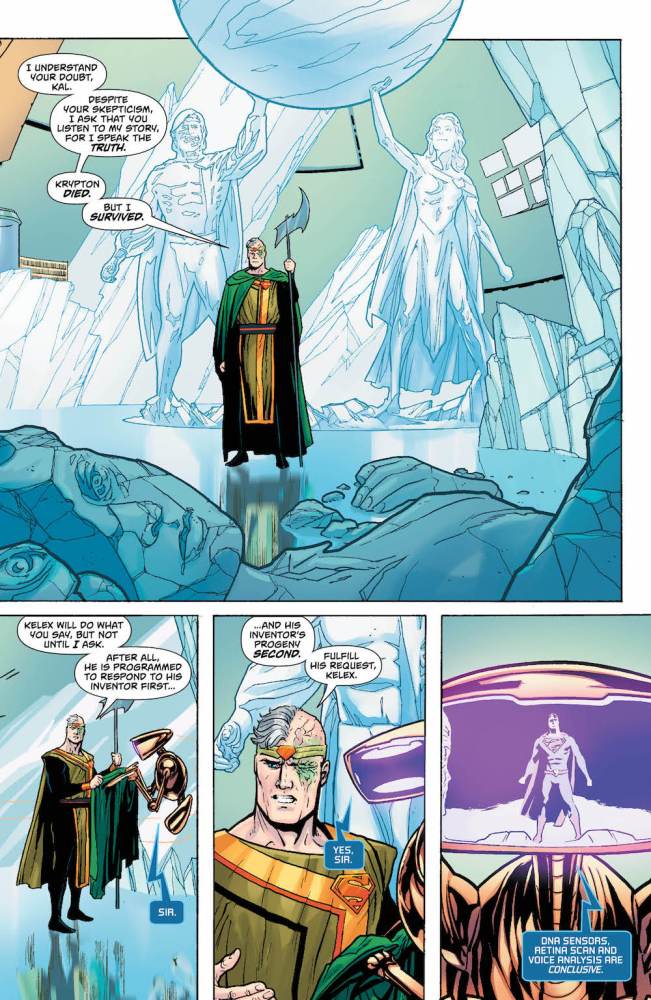
Corrina: Jor-El? This revelation is not doing much for me. Between all the twisting of heroes for the METAL crossovers and the need to rewrite every hero’s origin lately (Tim Drake obviously being the exception….) I throw up my hands at the idea of Jor-El as the anti-hero and his supposed survival. (And, yes, I agree with Ray’s point. Just once it would be interesting if it’s Mom who survives….)
Yes, I used to love the imaginary stories where Superman visited Krypton or the alternate history stories in which Krypton never exploded. But this isn’t that, it’s a complication of Superman’s origin, a complication that isn’t needed. He has the perfect origin: Doomed Planet. Kindly Couple. Champion of Justice. Can’t we move forward and have something new? No, we can’t, because DC at this point moving sideways, having fun playing with all its toys and basically mixing and matching his heroes like in that Marvel figures where you can mix up two heroes/villains.
And it’s not needed. Why does Superman need another father and son story? We already have Jonathan and Clark. And Clark and Jon. Now we have cranky, all-powerful grandpa? Who’s basically a slightly more sympathetic version of Zod? Well written, yes. Necessary? I don’t believe so.
The Hellblazer #14 – Tim Seeley, Writer; Jesus Merino, Artist; Carrie Strachan, Colorist
Ray – 8.5/10
Corrina: Awesome Spell
Ray: Tim Seeley’s run on Hellblazer turned out to only be one arc, as he’s on to bigger titles and this book is getting its third writer soon. And that’s a shame because this is easily the best this title has been since the heyday of Tynion and Doyle in the previous volume. It’s a gritty, suspenseful horror drama set in the London underground, as Constantine grapples with both supernatural forces and his biggest enemy – his own personal weaknesses. As the issue opens, London detectives – including Constantine’s former lover Detective Ames – are trying to figure out the case of the unfortunate man who got pulped by an air vent last issue. Constantine, who has figured out that he was the killer while under the influence of cursed liquor, is investigating as well.
That takes him back to the bar where all this began. Now, it’s a hip liquor lounge, but it’s also a former dive where he met Margaret Ames in the middle of a bar brawl years ago, and he uses a magic spell involving bacon fat, of all things, to relive both that, and the origin of the cursed ale that got him. This is an issue that involves bar brawls, Nordic myths involving dwarves, and a decapitated head singing rap music. And yet, somehow it all works, weaving together into a creepy, darkly funny horror story that takes Constantine to dark places and leaves him reluctantly deciding to be a hero again. The story concludes next issue, and it seems like it’s going to be a strong addition to his lore for any longtime fans since the Vertigo days.

Corrina: If this issue only concerned itself with the spell Constantine weaves to have the bar share its memories, it would be one of my favorite issues since the Doyle/Tynion run. As the bar’s life flashed by, in sequences that allow Merino to show off, I started to fall in love with the place. Then, naturally, Constantine does a Constantine thing and has to destroy it at the end. Ouch. But it very much encapsulates the character and his story world.
And, I almost physically jumped when those things appeared on the shoulders of the group that Constantine drank with, the beings who are obviously responsible for the murder. So it wasn’t just John being careless, it was also him being manipulated by unseen demons. (I suppose one could say those demons are a nice mirror for Constantine’s darker impulses, which adds yet another layer of meaning to this story.)
Justice League of America #15 – Steve Orlando, Writer; Felipe Watanabe, Penciller; Ruy Jose, Inker; Marcelo Maiolo, Colorist
Ray – 8.5/10
Corrina: How Did the Microverse Get This Messed Up?
Ray: The cover of this issue kind of amuses me, spotlighting the heroes of the Justice League of America fighting alongside Ray Palmer – when in fact, none of them appear in the issue after the first page save for Ryan in flashbacks. This is a Ray Palmer spotlight issue, covering his time missing in the Microverse and how he met his two closest allies. It opens where we left off, with Ray expressing his horror that the League brought Aron Aut to his hiding place, and then we cut to the beginning, as Ray Palmer discovers the crisis in the Microverse, and makes contact with Aron for the first time. Leaving his legacy to Ryan, he travels into the Microverse and finds a world collapsing. He and Aut begin their investigation into the crisis and witness some fantastic special effects in the process. However, it’s not until they meet the young Docent named Preon that their journey really begins.
When we met Aut and Preon, it was clear that there was bad blood between them. Aut was quick to accuse Preon of being a thief and con woman, but what we see here is very different. Preon is a kind but grief-stricken woman who is hesitant to take the risk of leaving her home, while Aut is driven, almost obsessed. They have very different ideas of how to proceed, but they are allies at first. That, however, is tested when Preon and Palmer develop a romantic connection (which felt like a bit of an unnecessary subplot in this issue). Their journey takes them to locations as they collapse faster and faster, and they’re forced into battle against – and for – the strange creatures within. The issue doesn’t reveal what Aut’s secret is, or why Palmer went into hidden exile, but the mystery is unraveling, in a fascinating issue that pulls the focus away from the main cast to great effect.
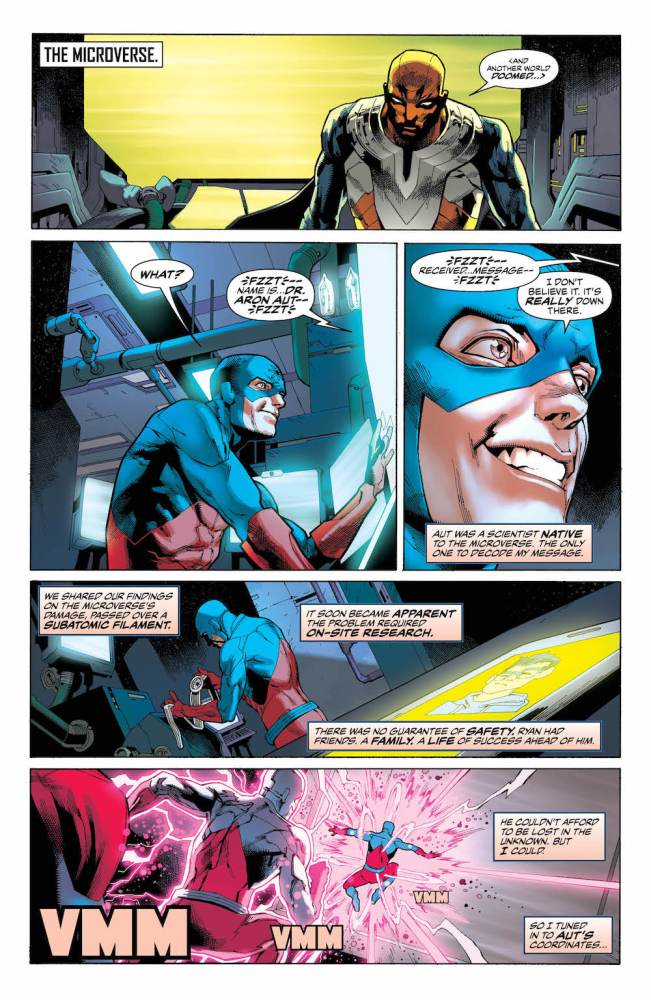
Corrina: Much like Dectective this week, this is a “how did we get here?” kind of story. And it’s probably the best Ray Palmer story in at least a decade as well, as it manages to incorporate all sorts of bits and pieces from previous incarnations (even Justice League Unlimited) and introduces new readers to a character that haven’t seen in a while.
That was a great success except..well…I’m still on pins and needles as to what happens next in the story. How do we get out of here? Can the Microverse be saved? And will Ray come back to the full-sized world or will he end up staying as the Microverse champion? Stay tuned!
Batgirl #15 – Hope Larson, Writer; Chris Wildgoose, Penciller; Jose Marzan Jr., Inker; Mat Lopes, Colorist
Ray – 8/10
Corrina: The Tone Seems a Note Off
Ray: A strong, multigenerational mystery unfolds as Batgirl and Nightwing confront one of the specters of their past in this second chapter. The issue kicks off with the two heroes dealing with Mad Hatter, who goes into a seizure after giving them the name of the villain of this arc – the Red Queen. While they try to save his life, another crisis emerges in the form of a doctor in the hospital going berserk and attacking a nurse. However, when Batgirl and Nightwing try to stop her, things get out of control, with the doctor displaying superhuman strength, immunity to pain, and an unstoppable will to kill everything around her. This segment actually gets pretty graphic in places, with the possessed doctor showing zero regards for her own safety.
Flashbacks give some vital context to this behavior, as it shows that this isn’t the first time incidents like this happened. As teenagers, Dick and Barbara investigated a mysterious new drug making the rounds in Gotham. Although nothing in the users’ systems turns up as positive for drugs, they experience intense hallucinations and some turn violent. In the present day, an attempt to scan the doctor with an MRI reveals that her body is primarily composed of nanobots – which leads to her being vaporized. This all comes back to Ainsley, Barbara’s former friend from high school who had an obsession with nanobots, and a mysterious secret involving ties to crime. There’s a lot being teased here, but it wouldn’t work without the genuine camaraderie and friendship between Barbara and Dick.

Corrina: If anything, this story is too packed, its ambition is to define the past and current relationship of Dick and Babs. I’m all for the ambition but, so far, bits and pieces of this story have been great, while others make me raise my eyebrows.
Take, for instance, Dick’s insistence on instantly experimenting with the infected doctor via the MRI. She was already restrained. A little more research–which is Babs’ territory–would have avoided a tragedy and it bothered me that this is yet another death in this arc that they couldn’t prevent or they contributed to by their actions.
The friendship between Dick and Babs works. The superhero teamwork does not wholly work.
The Flash #31 – Joshua Williamson, Writer; Neil Googe, Gus Vasquez, Artists; Ivan Plascencia, Colorist
Ray – 8/10
Corrina: Barry Slows Down
Ray: A lot happening in the conclusion of Bloodwork, as Barry faces off with the newest member of his rogues gallery, but takes his hardest losses in the personal realm as his Negative Speed Force powers take their toll. The villain, Bloodwork, is one of the creepiest we’ve ever seen in this title – there’s similarities to Clayface in powers, sure, but the fact that he’s essentially made of congealed blood adds a new level of horror. However, Barry understands that this is a person with out-of-control powers and a lot of fears driving them – something he can relate to. He’s able to talk Ramsey down just long enough to neutralize Bloodwork’s powers. Ramsey, a coroner, attempts to pull a fast one and argue that there’s no evidence of his crimes (because he destroyed it), but Kristen comes through and finds evidence he missed.
However, when she tries to give Barry some of the credit, he declines, explaining he had nothing to do with the collar. This act of decency comes back to bite him, as Singh decides he’s had enough of Barry’s flighty nature and packs him off to the crime investigation team at Iron Heights – and sends an angry, resentful Kristen with him as his partner. Realizing the damage his stint as the Negative Flash – as well as his lies and secrets before – have done to his personal life, he seeks out Wally, and after a tense confrontation, he tells Wally that he’s planning to retire as Flash for the time being until he sorts out his powers and gives the young speedster his ring. Kid Flash impresses, though, and instead offers to train Barry to help him figure out his new powers. While the title isn’t quite on the level of the excellent first arc, Williamson’s got to be commended for the great work he’s done with young Wally in particular.

Corrina: The descent into Barry’s version of the “Born Again” storyline seems over a bit quickly in this issue, as his abrupt realization for what he’s done seemed to come without much reflection. I suppose Bloodwork is the last straw that leads him to decide to stop and I’ll go with that.
And while I know sending him to Iron Heights and the criminal investigation there is meant to be an exile, the in-story reasoning seems suspect. Hey, you have an unreliable and possibly volatile employee, so you send him to an even more stressful job working with super villains? Singh, that seems like a bad choice. As a reader, I was ready for Barry to be fired.
But, naturally, Barry’s presence at Iron Heights will intersect with the Rogues, who’ve probably been planning something since Flash caught them some time back. Which should bring us to the next arc.
Justice League/Power Rangers #6 – Tom Taylor, Writer; Stephen Byrne, Artist
Ray – 8.5/10
Ray: Another strong climatic issue of an inter-company crossover this week, as the Justice League’s team-up with the classic teenage superhero team pits them against an army of their most powerful enemies. Last issue’s cliffhanger saw the coolest moment of the series, as Alpha Five grew to massive size to take on one of Lord Zedd’s monsters. While he’s strong, he’s also clumsy, and the heroes spend as much time trying to protect civilians from the chaos of the battle as they do fighting the villains. I didn’t think a proper understanding of the physics of superhero battles would be one of this series’ strong points, but it is! With the villains occupied, the Rangers are able to focus on protecting the kidnapped city of Angel Grove.
The villains pull out all the stops here, with Brainiac attempting to hack Cyborg and use him as a trojan horse to destroy the League. However, Cyborg saw this coming and pulled a fast one, infecting Brainiac with a virus of his own. With Zedd’s army collapsing around him, he pulls the final card he has, and grows to giant size for a battle with the Megazord that provides some of the best visuals of the issue. With the villains fleeing, and Angel Grove restored, the heroes are able to enjoy some time off in one of the best scenes of the issue, including a great gag about DCU money – although I question why Luthor would be on any bills. He left office after donning a robot suit and trying to kill Superman! With a cliffhanger promising more adventures, this is another big win for DC’s crossover business in the last year.
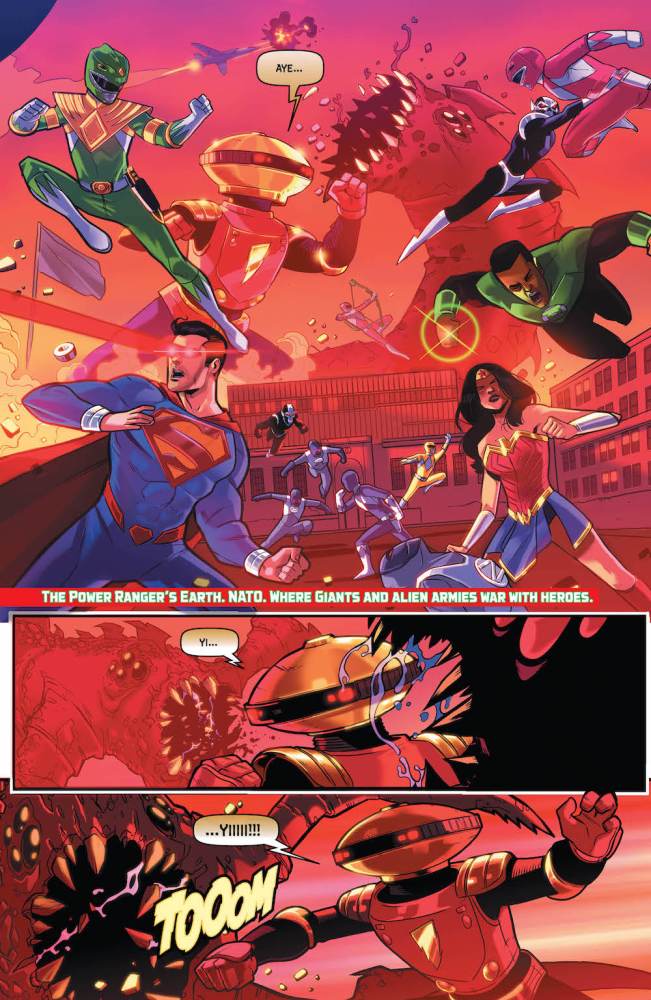
Hal Jordan and the Green Lantern Corps #29 – Robert Venditti, Writer; Rafa Sandoval, Penciller; Jordi Tarragona, Inker; Tomeu Morey, Colorist
Ray – 8/10
Ray: After two issues that were almost entirely action and a previous issue that pulled the focus back to Hal and his complex relationship with his deceased father, this title finds a good balance for the concluding issue of the arc – although it’s still a bit hard to square with both the previous New 52 New Gods arc, and the current Mister Miracle series. With Orion in stasis, kept alive by Kyle Rayner’s will while the Green Lanterns try to prevent the giant space robots from finding him, it comes down to a desperate last stand at the Source Wall. The role of these juggernauts becomes clear – they’re trying to release Yuga Khan, the evil forefather of the New Gods and Highfather’s father. The real star of this issue is Rafa Sandoval and the rest of the art team, who are at their absolute best doing widescreen action in space.
The best way to describe this issue is “Top Gun in Space”, which is basically what most of Hal Jordan’s stories are. He’s a daredevil flyboy, and he’s surrounded by fellow pilots who are either even more reckless or a good balance. His stories are best when they embrace that and let him and his allies pull off crazy moves like they do this issue. It’s big, loud, explosive, and filled with moments that set the heart racing. While most of the issue is just pure action, this issue doesn’t lose sight of what made last issue so good, which is that there’s genuine emotion at points. Highfather, a character who tends to be fairly one-note (and seems to be dead in Mister Miracle) gets a great scene where he grapples with his father’s legacy and his own role as a father. This book has been up and down through its entire run, and even this arc, but it ends on a high note.
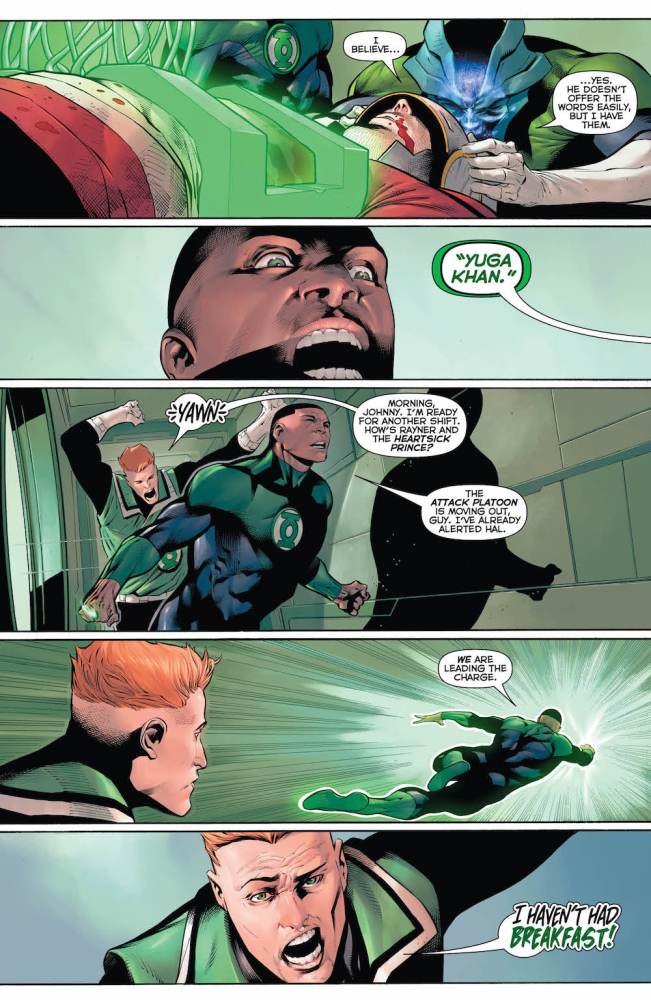
Corrina: For me, never having been a fan of Hal Jordan, this series has veered from good to tolerable to the not-good Soranik story and back to very good again. Juxtaposing Highfather/Orion and Hal/Martin over the last two issues is a clear thematic point, about fathers and sons and the legacies they leave behind, even including the ultimate father, the evil Yugo Khan.
This issue belongs to Hal but the other Lanterns also have some fine moments in the last stand at the Source Wall, even Kyle who’s behind the scenes in support. As always, Venditti handles the various GLs without losing sight of their individuality.
Good Issues: Grades 7-8
Bombshells United #2 – Marguerite Bennett, Writer; Marguerite Sauvage, Marcelo DiChiara, Artists; J. Nanjan, Colorist
Ray – 7.5/10
Corrina: Who Can You Trust?
Ray: After the first issue of Bombshells United plunged Wonder Woman into an uncertain new world, where her enemies were her allies in the United States, her allies were teenage outlaws fighting an unjust system, and nothing was as it seems, the second issue doubles down on the surreal new vibe of the series by pitting Diana against Clayface. It’s a bit jarring to see Clayface as this racist mutant monster, coming off his turn as a hero in Detective, but Bennett does a great job turning him into a legit threat. With the rain pouring down in the opening segment, he melts into the ground and comes back out again, bigger and stronger. Less strong are the segments involving Dawnstar, who speaks mainly in puzzling talk about alternate worlds.
The second segment focuses on Diana’s new team of allies, including Donna, Cassie, and a group of original characters. As they escape captivity and keep a watch out for Clayface’s infiltration, cracks begin to emerge in the group, and they start to question whether Clayface might have infiltrated the group. After a test involving Diana’s lasso, they find where Clayface is hiding and gather for a new fight. This segment has some good characterization and gives us a little more info on the new girls, but it also has a new artist and their debut doesn’t quite work. There’s a cartoony vibe to the art in places that undermines the serious, suspenseful tone of this always-strong series.
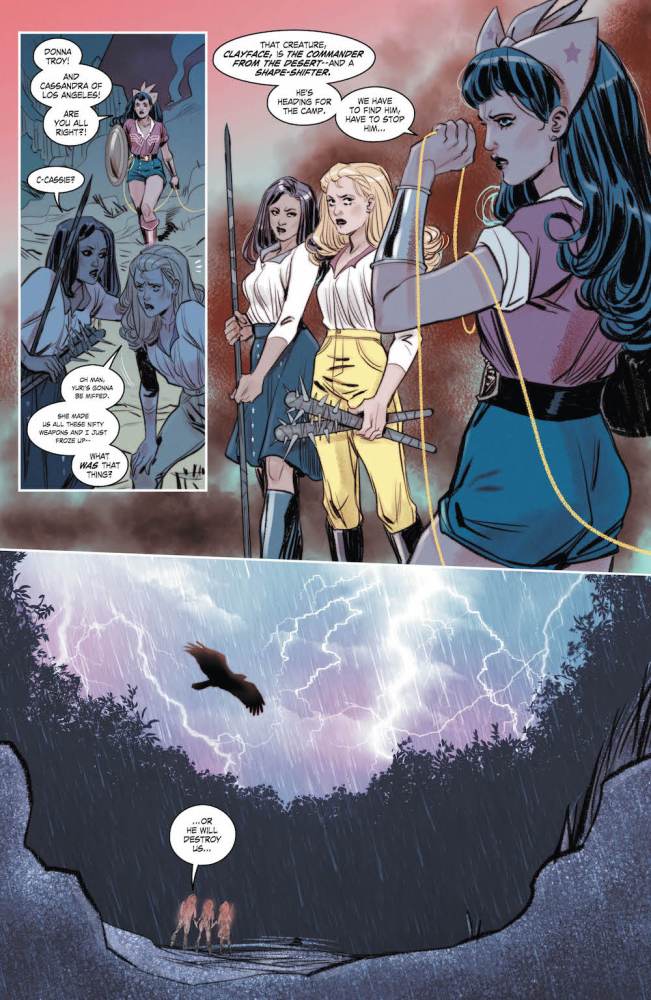
Corrina: What I love about this issue is that Clayface is being used to showcase how easily paranoia can take hold in a population, how easily suspicion can become anger, and then become action, such as rounding up people and putting them in work camps. It’s easy to see why Bennett was drawn to use Clayface, as he is the perfect metaphor for this situation.
On Dawnstar, I’m so happy to see her back in something that I’ll take whatever I can get, and I found her explanation for existing in all dimensions at once fascinating, as it opens a new aspect ofher character that could potentially be used if DC ever gets around to publishing a great Legion of Super-Hero book again.
Mother Panic #11 – Jody Houser, Jim Krueger, Writers; Shawn Crystal, Artist; Phil Hester, Penciller; Ande Parks, Inker; Jean-Francois Beaulieu, Trish Mulvihill, Colorists
Ray – 7/10
Ray: Mother Panic reaches the end of its first major story arc, as Violet pays a visit to an old girlfriend from Gather House who is one of the only survivors of the fire she started. The opening segment has some nice emotional intensity and plays with the element of Violet staying masked during the entire affair, but overall a lot of the themes we’ve seen in this title are played out again. Violet’s ex is in an abusive relationship, and she’s determined to make her escape. Shawn Crystal’s guest art looks great in the wide vistas, but up close it has some major issues. The unnamed girl from Violet’s past, when she smiles or laughs, looks almost Joker-esque in points. But the art, in the more surreal moments, has a distinctly creepy vibe.
The subplots may be stronger. Ratcatcher’s addition to the story, and his role in figuring out exactly what’s up with Violet’s mother held my interest pretty well. The villains in this title tend to be mysterious and grotesque. The twisted painter who is pulled into the revenge scheme against the abusive husband provides some great, horrific moments, but she – like everyone else – suffers from a slightly vague motivation. You’ve got a story with a good vibe for the darker corners of Gotham, but it still hasn’t gelled together as a whole like some of the other Young Animal books have. The backup, reaching its conclusion, finally shows us a bit more of the mystery, but it’s hard to follow three pages at a time from issue to issue.
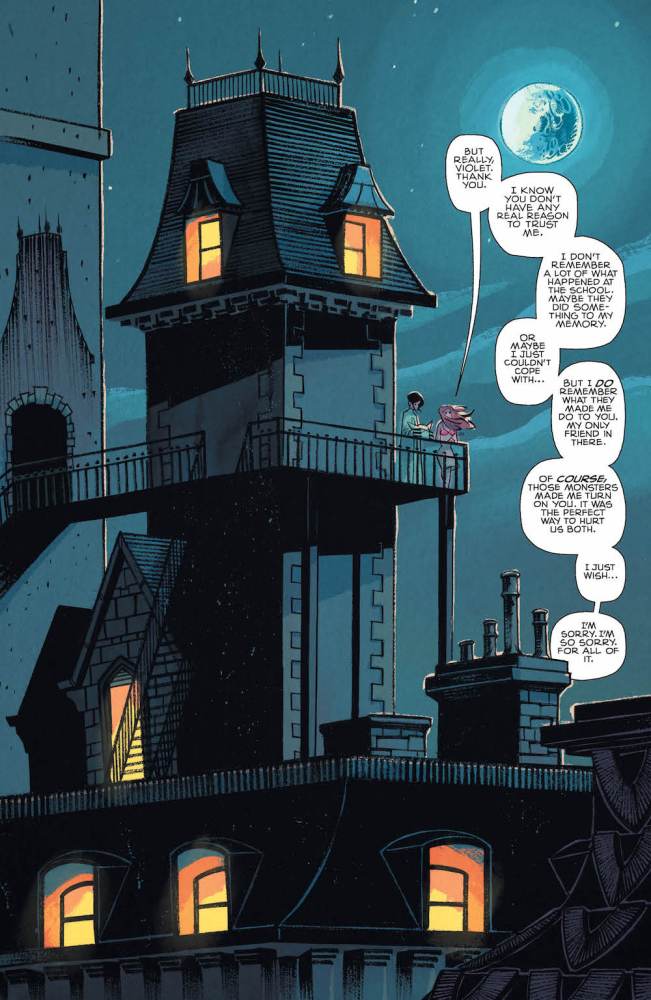
Scooby Doo Team-Up #30 – Sholly Fisch, Writer; Dario Brizuela, Artist; Franco Riesco, Colorist
Ray – 7.5/10
Ray: The cover of this title advertises this issue as a team-up with the Challengers of the Unknown, but it’s actually much more than that – maybe a little too much more. The setup is one of the most deep-cut concepts the title’s done yet, with a secret government agency being contacted to help the mythical Gnome King find the ingredients for a secret elixir that will save the world. One agent calls Mystery Inc., the other calls the Challengers, and the two bands of adventurers quickly get into a rivalry for who gets to play hero. They both go on their way, and encounter other adventurers along the way.
Their first stop takes them to the deep see, where they battle a plesiosaur and meet the Sea Devils. Next, it’s deep underground where they’re saved from a giant rat monster by Cave Carson (who does not have a cybernetic eye). Finally, they head to Challengers Mountain where they encounter the original Secret Six, reveal the true nature of the Gnome King, and save the world. It’s a fun comic, for sure, but with dozens of characters, I don’t think it would really sell new readers. Still, I have to applaud Fisch for his commitment to digging through the back of DC’s catalogue for his team-ups.
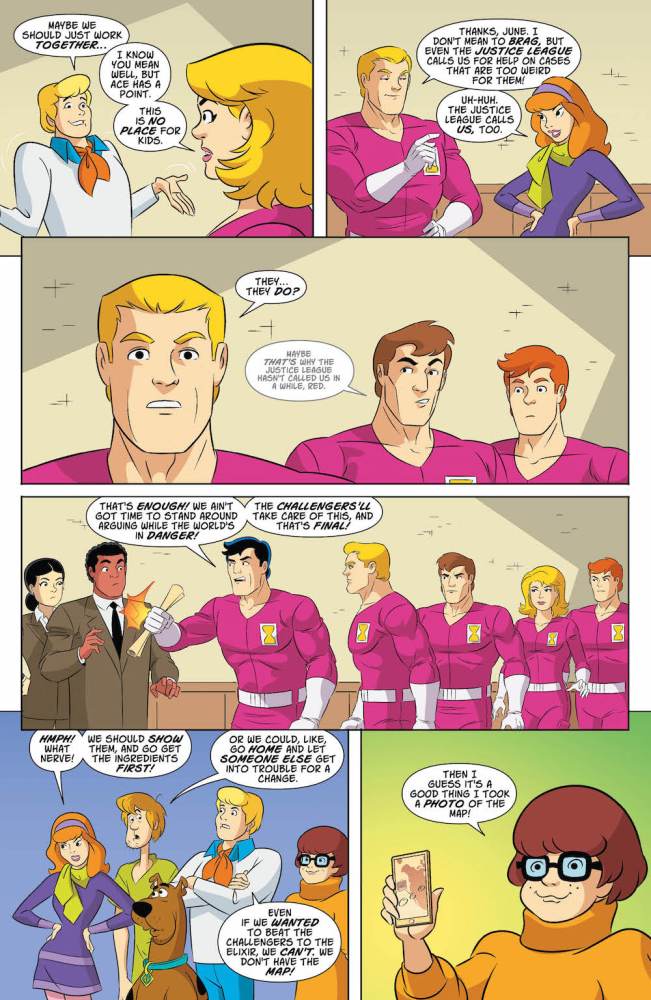
Batman: The Murder Machine #1 – Frank Tieri, James Tynion IV, Writer; Riccardo Federici, Artist; Rain Beredo, Colorist
Ray – 7/10
Corrina: More Metal
Ray: The second Dark Knights special takes us inside the world of a disturbing Batman/Cyborg hybrid, and while it’s much more of a horror book than last issue’s superhero-oriented “Red Death”, it’s also unfortunately not nearly as compelling a story. The issue’s best asset is Riccardo Federici’s smooth, slightly surreal art that perfectly captures a technological dystopia. Unfortunately, the Batman at its core seems more like a guy in a horror movie that makes every single bad decision he possibly can. The issue spends a good deal more of its time on the main world, as Cyborg is holding down the fort at the watchtower when he comes under attack by an evil Batman with his powers that seems to understand Cyborg’s technology better than he ever did, and has nefarious plans for Cyborg’s father.
The flashback segment shows how this Batman came to be corrupted, and it all started with the death of the person who was always holding Bruce back from the brink – Alfred. When Alfred is beaten to death by Bane in the Batcave, Bruce becomes increasingly unhinged, focused on bringing him back as a computer program that can fulfill Alfred’s role. He just needs Cyborg to bring it online, and while Cyborg is hesitant, he agrees – a decision that quickly spirals out of control when the program starts replicating itself, assassinating the Bat-rogues, and eventually assimilating Batman to keep him healthy. While there are some oddly genuine emotional beats to these segments, ultimately this Batman isn’t even really himself anymore. He’s almost a bystander in his own corruption, and that makes him likely to be the least compelling of the Dark Knights as this story unfolds.
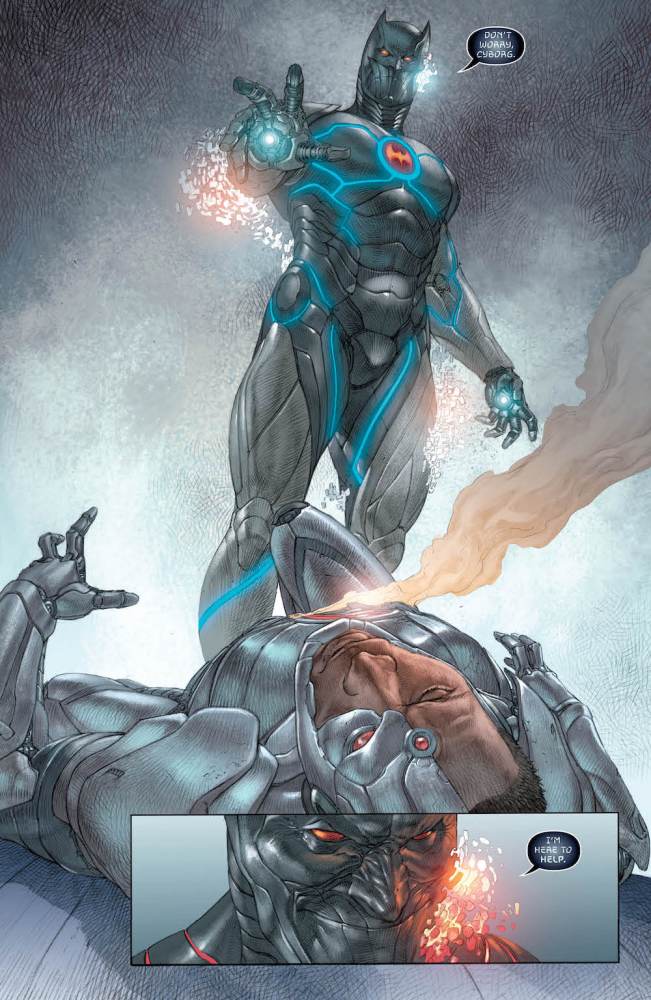
Corrina: So, this whole “Metal is cool and we’re riffing” is already beginning to feel like the same riff. Each Batman is driven to darkness by death: sometimes everyone, sometimes the world, sometimes Alfred, I guess, who’s become Batman’s Lois Lane–at least in using his death as motivation/going over the edge.
There’s something cool in the idea of a computer Alfred going overboard to “fix” the world but it’s too similar to how other AIs seem to operate in cleansing worlds for this concept to overcome the rest of the books flaws. For those loving the Metal event, it’s a decent issue and worth buying for the Bruce/Alfred relationship.
Wonder Woman #31 – James Robinson, Writer; Carlo Pagulayan, Penciller; Sean Parsons, Jason Paz, Scott Hanna, Inkers; Romulo Fajardo Jr., Colorist
Ray – 7/10
Corrina: Previews Not What It Seemed
Ray: The new run James Robinson ran into trouble with the fanbase for a number of reasons right away – another run by a male writer, a run focusing on the dangling subplot of WW having a secret brother – but Robinson’s done some good work and most people were willing to give it a chance. After reading the first issue, it’s clear that this is a technically competent run – Deathstroke artist Carlo Pagulayan is at home drawing epic battles, and Robinson’s dialogue is strong – but it has one major problem that will sour a lot of people off this comic right away. Its fatal problem is that it’s not a Wonder Woman comic. She appears in about four pages of this issue – the opening panel, a flash-forward, and a brief segment towards the end.
Instead, the bulk of the issue focuses on a bearded man named Paul Jackson who lives out in the woods, has super-strength, and raises the attention of the evil Grail, Darkseid’s daughter. She attacks him, and he turns out to be Hercules, who fights valiantly but eventually falls, his powers drained by Grail. The issue then cuts to Diana fighting Giganta, and defeating her while also making sure she doesn’t hurt any civilians. This is the issue’s best segment, a promising hint of the title’s future. Robinson does clearly get Diana, as well as Steve Trevor. But the segment is soon taken over by a lawyer informing Diana that she’s inherited Herc’s fortune, and soon we’re cutting to Grail bringing Baby Darkseid – now a growing child – the energy of the children of Zeus to feed on. It’s not that this run is a bad start, per se, but that it’s very much not the start it needed to sell WW fans on a controversial concept.

Corrina: Grail wasn’t interesting in the Darkseid War, not a good a sign for this run because Robinson brings no new angles to her. Ditto for baby Darkseid. But I am amused that the preview pages of this issue made it seem like the Hercules character would play a larger part in the story, only to be dispatched almost immediately by Grail.
As Ray said, it’s competently written but it’s mostly all setup to the larger tale. The small part that is Diana’s part of the story is good–she’s in character–but nothing about the plot is grabbing me.
Nightwing: The New Order #2 – Kyle Higgins, Writer; Trevor McCarthy, Artist; Dean White, Colorist
Ray – 7.5/10
Corrina: Fascist Non-Powered Regime
Ray: Kyle Higgins’ dystopian take on the hero he wrote for years in the New 52 was always going to be a hard sell. Dick Grayson is one of the most decent heroes in the DCU. What scenario is there where he becomes a villain? Well, this issue makes pretty clear he’s not supposed to be – he’s the man who sold his soul to keep a terrible system from getting worse. And now his son is caught up in that same system. The beginning of the issue shows how the current regime emerged, through the eyes of Dick’s son Jake. Much like in Civil War, metahuman powers resulted in tragedy until the people demanded action, and Dick went along with it. This segment also reveals Jake’s mother as Starfire, and he’s inherited her powers (although that’s a logical flaw – Kory isn’t a metahuman).
Higgins does understand Dick Grayson’s character, and so the segments where we can see the remnants of the man who he used to be are the best. His desperation to keep his son from falling into the system he helped create, and his conversation with his son in the aftermath, are among the best scenes of the issue. And of course, we can’t forget Alfred, always the voice of conscience and the man who stuck by Dick even as he considers him to be a disgrace. It’s Alfred that figures prominently into the climax of the issue (these AUs never seem to go well for him), as the system Dick built turns on him and his family with alarming speed. Despite still having some major issues with the concept, it’s turning out to be executed far better than I expected.

Corrina: This series posits that villains don’t kill people–their powers do. And so we finally glance the reasoning behind Dick’s need to take away everyone’s powers. He’s the one that pulled the trigger on all this and he’s the one held up as a normal human hero. (This, of course, doesn’t take into account that Nightwing and Batman villains tend to develop dangerous powers in order to combat our heroes, so, if heroes are attracting the villains, it doesn’t matter if they’re powered.)
But Dick is still essentially a good guy, at least we think so because he wants to protect his son. He’s also written as a bit clueless to exactly what he’s unleashed. Alfred, of course, sees as clearly as he always has. Is there a commentary about police raids in how Alfred dies? Perhaps, especially in a story subtitled “New Order.” But, in the end, it will likely be Dick against the system. Overall, a better issue than the first one but I still find the premise unbelievable.
Needs Works: Grades 6 and Below
Suicide Squad #26 – Rob Williams, Writer; Stepan Sejic, Artist
Ray – 6/10
Corrina: Sejic Art! Great!
Ray: Tie-ins generally match the quality of the series they’re in, and that’s the case in this installment of The Resistance. Suicide Squad, consistently the weakest DC Rebirth title, is the weakest chapter here as well, although it improves on the title’s usual fare due to a quality central storyline to play off and a great guest artist in Stepan Sejic. The issue starts with Waller briefing the team on what’s going on in Gotham and sending them in to maintain order. Croc, who is unusually invested in Gotham City, is the most gung-ho. They immediately cross paths with Poison Ivy – who, normally, would be happy to see Harley, but instead tries to kill her with giant plant. She’s apparently gotten ahold of one of the Batman Who Laughs’ cards, and it’s driven her more than a little insane. Why she would accept the card isn’t explained, but at least the plant effects are great.
The strongest point in this issue is the visuals, which opens with insane sights like the entire crew riding down post-apocalyptic Gotham roads with vicious Man-Bats in pursuit. Then, soon enough they’re under attack by a Jokerized Starfire, who inadvertently get them out of a tight spot and into the fire, as they encounter a team combined of the missing Titans and Squad. The fight scenes are a bit jumbled, and the issue attempts to work in some genuine emotion between Dick and Damian (when they get evidence that Batman may be dead), but the dialogue, unfortunately, isn’t really up to the task, feeling forced. The best moment of the issue is a surprise guest appearance in the cliffhanger. This issue pushes the plot forward, dropping in all the required story beats, but it doesn’t really add any of its own flair in the way the Teen Titans or Nightwing issues did.
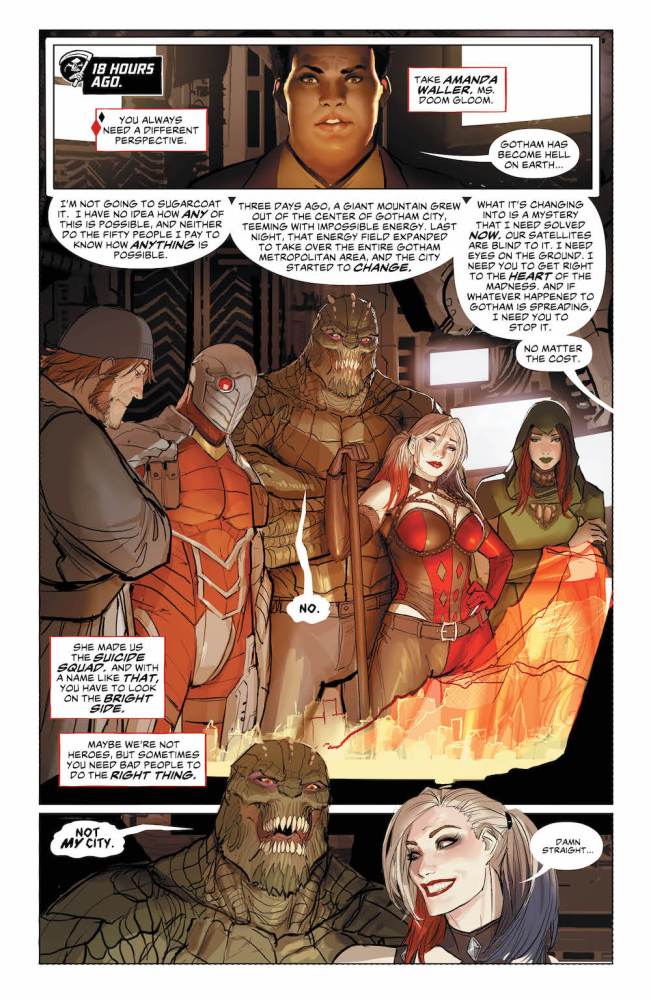
Corrina: If you ever wondered how much art affects the quality of a story, compare the last issue of this series to this issue, and the difference is crystal clear. Sejic’s art draws you into the story world, making it lush and allowing the reader to sink into it. Which is good because it kept me turning the pages long after I’d had enough with Jokerized everybody.
Blue Beetle #13 – Keith Giffen, JM DeMatteis, Writers; Scott Kolins, Artist; Romulo Fajardo Jr., Colorist
Ray – 5/10
Corrina: The Conclusion of JL3001
Ray: The final issue of the Giffen/DeMatteis creative team delivers a weird issue that barely even qualifies as a Blue Beetle issue. Rather, it’s a strange sequel to the previous run by these creators, Justice League 3001. And like the most recent issue of Superman, I’m not sure having a random callback to a three-years-old issue is a good idea. The issue starts with Jaime helping Teri and Tina power a cosmic treadmill to return them to the 31st century, but after an explosion, Tina gets left behind, and Jaime gets pulled along with Teri right into the middle of the battle she left. The Justice League of the future is in the middle of fighting superheroes possessed by Lady Styx, the main villain of the previous run.
Problem is, this weird all-female league composed of clones has an extended backstory, none of which is explained here. Wonder Woman, who is actually a clone of the original, is violent and seems determined to attack Jaime despite never seeing him before. There’s a whole, elaborate subplot involving Teri and her brother, who is now Eclipso, and then there’s the out of nowhere reveal that Lady Styx and La Dama are actually one and the same, which will likely never be followed up on outside this issue. Teri even narrates a large chunk of the issue, meaning that Jaime is essentially a guest star in this team’s finale on the title. Next up, Chris Sebela takes over for an arc, and I’m hoping he can get this title back to the core of what made the Rogers run so great.

Corrina: If you wanted a conclusion to the late but not lamented Justice League 3001, this is your issue. Otherwise, I can’t see any reason to recommend it because it reminds me of a premise that had promise but never quite worked, placed inside the book for a character who sorely needs more of the spotlight.
Disclaimer: GeekDad received these comics for review purposes.


